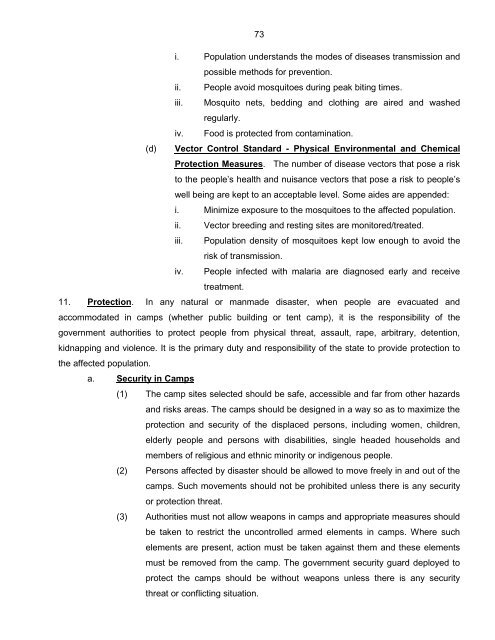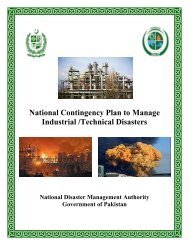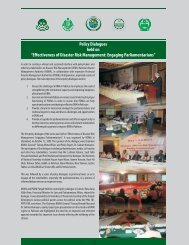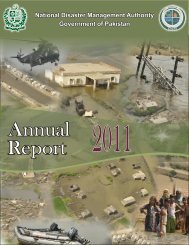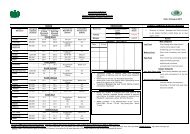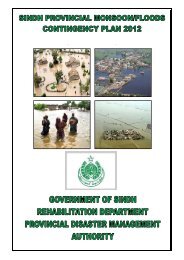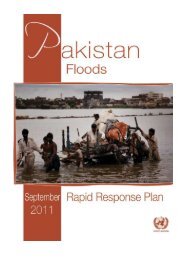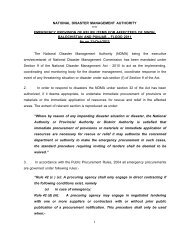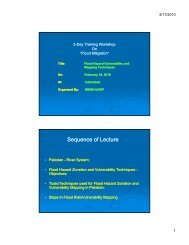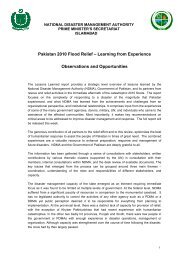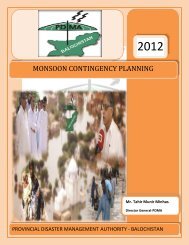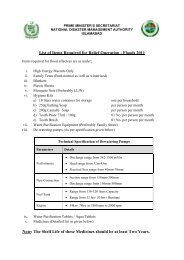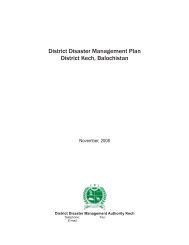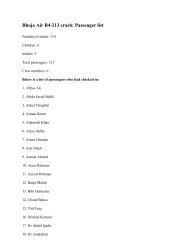National Disaster Response Plan (NDRP) March 2010 - NDMA
National Disaster Response Plan (NDRP) March 2010 - NDMA
National Disaster Response Plan (NDRP) March 2010 - NDMA
Create successful ePaper yourself
Turn your PDF publications into a flip-book with our unique Google optimized e-Paper software.
73<br />
i. Population understands the modes of diseases transmission and<br />
possible methods for prevention.<br />
ii. People avoid mosquitoes during peak biting times.<br />
iii. Mosquito nets, bedding and clothing are aired and washed<br />
regularly.<br />
iv. Food is protected from contamination.<br />
(d) Vector Control Standard - Physical Environmental and Chemical<br />
Protection Measures. The number of disease vectors that pose a risk<br />
to the people‟s health and nuisance vectors that pose a risk to people‟s<br />
well being are kept to an acceptable level. Some aides are appended:<br />
i. Minimize exposure to the mosquitoes to the affected population.<br />
ii. Vector breeding and resting sites are monitored/treated.<br />
iii. Population density of mosquitoes kept low enough to avoid the<br />
risk of transmission.<br />
iv. People infected with malaria are diagnosed early and receive<br />
treatment.<br />
11. Protection. In any natural or manmade disaster, when people are evacuated and<br />
accommodated in camps (whether public building or tent camp), it is the responsibility of the<br />
government authorities to protect people from physical threat, assault, rape, arbitrary, detention,<br />
kidnapping and violence. It is the primary duty and responsibility of the state to provide protection to<br />
the affected population.<br />
a. Security in Camps<br />
(1) The camp sites selected should be safe, accessible and far from other hazards<br />
and risks areas. The camps should be designed in a way so as to maximize the<br />
protection and security of the displaced persons, including women, children,<br />
elderly people and persons with disabilities, single headed households and<br />
members of religious and ethnic minority or indigenous people.<br />
(2) Persons affected by disaster should be allowed to move freely in and out of the<br />
camps. Such movements should not be prohibited unless there is any security<br />
or protection threat.<br />
(3) Authorities must not allow weapons in camps and appropriate measures should<br />
be taken to restrict the uncontrolled armed elements in camps. Where such<br />
elements are present, action must be taken against them and these elements<br />
must be removed from the camp. The government security guard deployed to<br />
protect the camps should be without weapons unless there is any security<br />
threat or conflicting situation.


